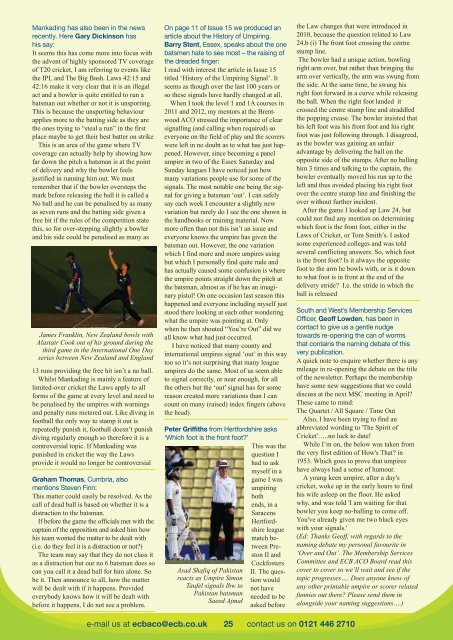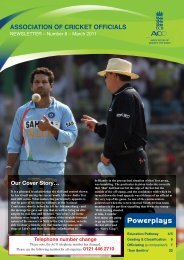ECB ACO Newsletter - Spring 2013
ECB ACO Newsletter - Spring 2013
ECB ACO Newsletter - Spring 2013
You also want an ePaper? Increase the reach of your titles
YUMPU automatically turns print PDFs into web optimized ePapers that Google loves.
Mankading has also been in the newsrecently. Here Gary Dickinson hashis say:It seems this has come more into focus withthe advent of highly sponsored TV coverageof T20 cricket, I am referring to events likethe IPL and The Big Bash. Laws 42:15 and42:16 make it very clear that it is an illegalact and a bowler is quite entitled to run abatsman out whether or not it is unsporting.This is because the unsporting behaviourapplies more to the batting side as they arethe ones trying to “steal a run” in the firstplace maybe to get their best batter on strikeThis is an area of the game where TVcoverage can actually help by showing howfar down the pitch a batsman is at the pointof delivery and why the bowler feelsjustified in running him out. We mustremember that if the bowler oversteps themark before releasing the ball it is called aNo ball and he can be penalised by as manyas seven runs and the batting side given afree hit if the rules of the competition statethis, so for over-stepping slightly a bowlerand his side could be penalised as many asJames Franklin, New Zealand bowls withAlastair Cook out of his ground during thethird game in the International One Dayseries between New Zealand and England13 runs providing the free hit isn’t a no ball.Whilst Mankading is mainly a feature oflimited-over cricket the Laws apply to allforms of the game at every level and need tobe penalised by the umpires with warningsand penalty runs metered out. Like diving infootball the only way to stamp it out isrepeatedly punish it, football doesn’t punishdiving regularly enough so therefore it is acontroversial topic. If Mankading waspunished in cricket the way the Lawsprovide it would no longer be controversialGraham Thomas, Cumbria, alsomentions Steven Finn:This matter could easily be resolved. As thecall of dead ball is based on whether it is adistraction to the batsman.If before the game the officials met with thecaptain of the opposition and asked him howhis team wonted the matter to be dealt with(i.e. do they feel it is a distraction or not?)The team may say that they do not class itas a distraction but our no 6 batsman does socan you call it a dead ball for him alone. Sobe it. Then announce to all, how the matterwill be dealt with if it happens. Providedeverybody knows how it will be dealt withbefore it happens, I do not see a problem.On page 11 of Issue 15 we produced anarticle about the History of Umpiring.Barry Stent, Essex, speaks about the onebatsmen hate to see most – the raising ofthe dreaded finger:I read with interest the article in Issue 15titled ‘History of the Umpiring Signal’. Itseems as though over the last 100 years orso these signals have hardly changed at all.When I took the level 1 and 1A courses in2011 and 2012, my mentors at the Brentwood<strong>ACO</strong> stressed the importance of clearsignalling (and calling when required) soeveryone on the field of play and the scorerswere left in no doubt as to what has just happened.However, since becoming a panelumpire in two of the Essex Saturday andSunday leagues I have noticed just howmany variations people use for some of thesignals. The most notable one being the signalfor giving a batsman ‘out’. I can safelysay each week I encounter a slightly newvariation but rarely do I see the one shown inthe handbooks or training material. Nowmore often than not this isn’t an issue andeveryone knows the umpire has given thebatsman out. However, the one variationwhich I find more and more umpires usingbut which I personally find quite rude andhas actually caused some confusion is wherethe umpire points straight down the pitch atthe batsman, almost as if he has an imaginarypistol! On one occasion last season thishappened and everyone including myself juststood there looking at each other wonderingwhat the umpire was pointing at. Onlywhen he then shouted “You’re Out” did weall know what had just occurred.I have noticed that many county andinternational umpires signal ‘out’ in this waytoo so it’s not surprising that many leagueumpires do the same. Most of us seem ableto signal correctly, or near enough, for allthe others but the ‘out’ signal has for somereason created more variations than I cancount on many (raised) index fingers (abovethe head).Peter Griffiths from Hertfordshire asks‘Which foot is the front foot?’This was thequestion Ihad to askmyself in agame I wasumpiringbothends, in aSaracensHertfordshireleaguematch betweenPrestonII andAsad Shafiq of Pakistanreacts as Umpire SimonTaufel signals lbw toPakistan batsmanSaeed AjmalCockfostersII. The questionwouldnot haveneeded to beasked beforethe Law changes that were introduced in2010, because the question related to Law24.b (i) The front foot crossing the centrestump line.The bowler had a unique action, bowlingright arm over, but rather than bringing thearm over vertically, the arm was swung fromthe side. At the same time, he swung hisright foot forward in a curve while releasingthe ball. When the right foot landed itcrossed the centre stump line and straddledthe popping crease. The bowler insisted thathis left foot was his front foot and his rightfoot was just following through. I disagreed,as the bowler was gaining an unfairadvantage by delivering the ball on theopposite side of the stumps. After no ballinghim 3 times and talking to the captain, thebowler eventually moved his run up to theleft and thus avoided placing his right footover the centre stump line and finishing theover without further incident.After the game I looked up Law 24, butcould not find any mention on determiningwhich foot is the front foot, either in theLaws of Cricket, or Tom Smith’s. I askedsome experienced colleges and was toldseveral conflicting answers. So, which footis the front foot? Is it always the oppositefoot to the arm he bowls with, or is it downto what foot is in front at the end of thedelivery stride? I.e. the stride in which theball is releasedSouth and West’s Membership ServicesOfficer, Geoff Lowden, has been incontact to give us a gentle nudgetowards re-opening the can of wormsthat contains the naming debate of thisvery publication.A quick note to enquire whether there is anymileage in re-opening the debate on the titleof the newsletter. Perhaps the membershiphave some new suggestions that we coulddiscuss at the next MSC meeting in April?These came to mind:The Quartet / All Square / Time OutAlso, I have been trying to find anabbreviated wording to 'The Spirit ofCricket'…..no luck to date!While I’m on, the below was taken fromthe very first edition of How's That? in1953. Which goes to prove that umpireshave always had a sense of humour.A young keen umpire, after a day'scricket, woke up in the early hours to findhis wife asleep on the floor. He askedwhy, and was told 'I am waiting for thatbowler you keep no-balling to come off.You've already given me two black eyeswith your signals.'(Ed: Thanks Geoff, with regards to thenaming debate my personal favourite in‘Over and Out’. The Membership ServicesCommittee and <strong>ECB</strong> <strong>ACO</strong> Board read thiscover to cover so we’ll wait and see if thetopic progresses…. Does anyone know ofany other printable umpire or scorer relatedfunnies out there? Please send them inalongside your naming suggestions….)e-mail us at ecbaco@ecb.co.uk 25 contact us on 0121 446 2710












![Indoor Sports Halls with Cricket Provision [TS3] - Ecb - England and ...](https://img.yumpu.com/49070696/1/190x135/indoor-sports-halls-with-cricket-provision-ts3-ecb-england-and-.jpg?quality=85)



